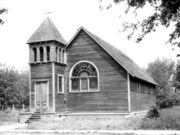The Church of the Nazarene is a conservative branch of the Wesleyan family of denominations. Nazarenes, whose Wesleyan-Arminian theological tradition is similar in belief to that of the United Methodist Church, have been active in Georgia since 1910. They have had an administrative district in the state since 1915. The Georgia District, led by an elected superintendent, has its headquarters in McDonough. As of 2010 it consisted of 9,452 members in 95 churches. The church also sponsors a campground in Adrian, in Emanuel County.
Georgia Nazarenes are part of a worldwide denomination based in Lenexa, Kansas. The largest of the Wesleyan-Arminian denominations, the Church of the Nazarene had in 2011 approximately 2 million members and 26,000 churches in 156 world areas. The Nazarene Publishing House in Kansas City, Missouri, is the largest publisher of Wesleyan literature. The church supports thirteen liberal arts institutions, as well as numerous other educational and medical facilities worldwide. This international emphasis is reflected in the satellite, Internet, and radio broadcasts of the church’s World Mission Broadcast, which produces programs in thirty-six languages.
The history of Nazarenes in Georgia dates back to an evangelical revival in eighteenth-century England led by John and Charles Wesley. The movement emphasized holiness in Christian living made possible by a second work of grace following salvation in a believer’s life. In nineteenth-century America this emphasis found expression primarily in independent holiness associations and traveling camp meetings. Three of these associations in different regions of the country united to form the Church of the Nazarene in 1907-8. The denomination became nationally organized on October 8, 1908, in Pilot Point, Texas, as the Pentecostal Church of the Nazarene. Several other groups swelled the church’s ranks after this date. In 1919 the group dropped the name “Pentecostal” in order to disassociate itself from the practice of speaking in unknown tongues.

Reprinted by Permission of Drew University Library
The earliest major Nazarene work in Georgia took place in Donalsonville, in the southwest corner of the state, where a strong congregation was supported mostly by the T. J. Shingler family. This congregation had been a part of the Georgia Holiness Association that merged in 1907 with the Holiness Church of Christ, one of the founding groups of the Church of the Nazarene. In 1910 the Shingler family donated forty acres of land to the new Nazarene denomination to establish a Bible college in the town. The school, Shingler Holiness University, opened in 1914. Five years later it relocated to Nashville, Tennessee, to merge with Trevecca College (later, Trevecca Nazarene University). Georgia Nazarenes quickly organized into an official Nazarene district that assembled for the first time in December 1915 in Glennville under the district superintendent W. R. Hanson.
The church’s beliefs share the backgrounds of Methodism and the nineteenth-century American Holiness Movement. The doctrines center on justification by faith, the total inspiration of the scriptures, and the atonement of Christ for all humankind. The most distinctive belief is called entire sanctification, which is based on the Wesleyan emphasis that Christians are called to a holy life marked by an act of God subsequent to salvation. Entire sanctification cleanses the believer of “original sin” (self-centeredness) and fills him or her with a love for God and humankind.





